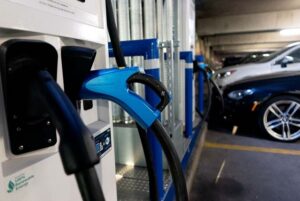 EV Charging Infrastructure Is a Growing Market
EV Charging Infrastructure Is a Growing Market
As electrification penetrates multiple vehicle segments, the types of charging infrastructure needed are also evolving.
During the past few years, the global electric vehicle (EV) industry has experienced tremendous growth.
Total global electric vehicle sales went from approximately 3.1 million in 2020 to over 9 million in 2022.
In its recent report, IDTechEx predicts more than 12 million EV sales in 2023 and exponential growth in the coming years—as many as 20 million EV sales in 2025.
Global sales of commercial EVs also more than doubled in 2021, and IDTechEx finds that large global truck makers expect 35 to 60% of their annual sales to be electric trucks by 2025.
EV charging infrastructure is growing as well. According to IDTechEx, there were nearly 2.7 million public charging points worldwide in 2022. Nearly 960k chargers were installed globally just in that same year.
IDTechEx estimates that 222 million charges will be needed by 2034 to support the growing global EV fleet. IDTechEx also predicts that the cumulative global investment in global charging infrastructure will exceed US$123 billion by 2034 (hardware cost alone).
There is undoubtedly a huge push to build global DC fast-charging networks. The US government is providing more than US$5 billion in funding and incentives as part of the NEVI program to build a coast-to-coast fast charging network, and many countries in Europe are rolling out similar programs following the AFIR regulations to spur EV charging infrastructure growth. 2023 will be a big year for EVs and EV charging, but there’s more to the story.
IDTechEx’s latest report, “Charging Infrastructure for Electric Vehicles and Fleets 2024-2034”, covers the trends and developments in the EV charging industry.
EV Charging Solutions Are Diverse
The IDTechEx report provides in-depth coverage of multiple types of EV charging solutions, including private AC charging, public DC charging, megawatt charging, battery swapping, and wireless charging. Vehicle platform voltages are shifting from 400 to 800 V architectures with the use of traction-integrated onboard DC charging, unlocking even higher charging powers while bringing new thermal challenges. The IDTechEx research aims to provide clarity on the different technologies available today and those emerging with potential for disruption in the future.
Technologies like destination or wallbox DC chargers, megawatt charging, robotic charging, battery-buffered charging, off-grid solar charging, and mobile charging are examples of the emerging EV charging solutions included in IDTechEx research. This report covers the key players within these fields, benchmarks their products, and provides a market outlook for their adoption.
Different Markets Have Different Characteristics
The amount of EV charging infrastructure, both publicly accessible and private, is surging, whether analyzed by installed capacity or number of charging points. The deployment of DC fast chargers has far outpaced that of AC chargers in the last few years. The number of charging points and their distribution is still important but not as singularly as before. As the capacity of EV batteries and the power that charging stations can dispense have increased, the metric of installed capacity per EV (and peak network capacity) has become more important than the number of charging stations per EV. Generally, in Europe, there is a trend seen in countries with the least number of public charging points to provide an above-average amount of installed charging capacity.
Countries with more public charging points tend to have a lot more AC chargers. They have usually started their EV transition earlier. Countries that have started their deployment later tend to have fewer stations but more high-powered DC ones. These differences are due to the state of technological development when a given country started deploying the chargers, how the charges were financed, and local market conditions.
When choosing between AC and DC charging for fleets, the choice comes down to the type of vehicle, battery size, and time available for charging with regard to duty cycles. Level 2 chargers provide sufficient power to recharge light and medium-duty vehicles overnight, but larger battery capacity long-haul trucks will require DC fast charging. Technologies like wireless charging and battery swapping have also been implemented successfully for fleets, with various cast studies included in the report.
The latest IDTechEx report aims to keep up with the changes and developments in EV charging by monitoring and analyzing the EV charging industry, its developments and regulations, and the latest technological trends and innovations.
For more info, click here.
